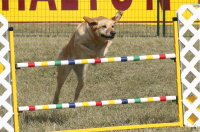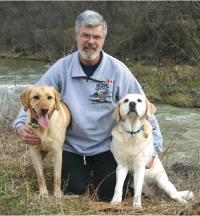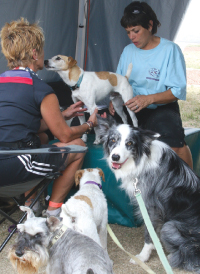
Best in Show: How chiropractic is helping animal athletes
By Larry McCarthy DC
Features Clinical TechniquesRocky was having trouble with his
starts, as he competed internationally last year. Briar, a big fellow,
could turn left quickly without any problem, but when he tried to cut
right, something didn’t feel right so he would have to slow down and be
more deliberate in his actions. Kelly would negotiate the hurdles just
fine, in the early stages of her event, but by the end she was knocking
hurdles over with her trailing leg. Dennis, an ex-athlete, now looking
older than he actually is, simply had trouble negotiating around his
home.
 |
| Vibe, a yellow Labrador Retriever, executes a competition jump. Photos by Dr. Larry McCarthy |
Rocky was having trouble with his starts, as he competed internationally last year. Briar, a big fellow, could turn left quickly without any problem, but when he tried to cut right, something didn’t feel right so he would have to slow down and be more deliberate in his actions. Kelly would negotiate the hurdles just fine, in the early stages of her event, but by the end she was knocking hurdles over with her trailing leg. Dennis, an ex-athlete, now looking older than he actually is, simply had trouble negotiating around his home.
Besides the fact that chiropractic treatment helped get them back on the field of play in record time, and continues to help them maintain their athletic abilities, what do these athletes have in common?
They’re dogs!
ANIMAL CHIROPRACTIC
If you think animal chiropractic is something new, consider that, in 1944, B.J. Palmer wrote, “In the early days of chiropractic, we maintained a veterinarian hospital where we adjusted the vertebral subluxations of sick cows, horses, cats, dogs . . . .”
Modern animal chiropractic began in the State of New Jersey in the early 1980s when a group calling itself Options for Animals began working on dogs. The project was short-lived, as legal action was launched against one of the chiropractors by veterinarians in the state. The organization was later revived when a veterinarian by the name of Dr. Sharon Willoughby enrolled and graduated from Palmer College of Chiropractic. Soon after that, “Options” opened a school for animal chiropractic. There are now three schools in the United States, one in Canada and one in Europe. The courses are open to any qualified chiropractor or veterinarian. In most jurisdictions in Canada and the U.S., completion of this program is mandatory for those who wish to practice animal chiropractic.
 |
| Above: Dr. McCarthy with Vibe (left) and Piper (right) Below: Athletes line up to be adjusted by Dr. Gloria Bracchetti at national competition. |
 |
ANIMAL ATHLETES
So, why is animal chiropractic becoming more widely used in the animal athletic world? The simple answer is that chiropractic works as well for animals as it does for humans.
As you might expect, the basic principles of chiropractic apply to our four-legged friends much as they do to us. Animal chiropractors are seeing the same problems with dogs, cats, and even rabbits, as they have seen with their human patients. The results, then, when applying this experience to animals, are predictably fantastic.
But the realm in which animal chiropractic seems to be most appreciated is the world of animal sporting events. Many animal chiropractors are visiting horse barns, treating the likes of thoroughbreds, trotters, pacers, jumpers and equestrian horses. As well, they are becoming sought after by participant and trial organizers in dog events, causing them to set up shop at canine athletic events such as flyball, agility, dock dogs and retriever trials.
Why are animal chiropractors becoming necessary for the competitors at these events? Could it be that it helps the animals feel better? Can it help correct the cause of their problems? Does it help maintain the health of their animal? Absolutely. It certainly does all that. However, the main reason handlers bring their animals to the chiropractor is because they have found that it gives them a competitive edge. Performance enhancement!
Canine and equine sports, just like human sports, are dependent on determining “who can do the job in the most efficient manner.” The competitor that does the best – wins! Chiropractic adjustments are giving these animals the ability to compete at their potential as well as enjoy their sport right through their senior years.
In the summer of 2007, four animal chiropractors were invited to attend the Agility Association of Canada’s National Championships. More than 600 dogs from all over Canada and the U.S. were registered for the event. The four animal chiropractors performed approximately 200 canine adjustments that weekend.
When many of the handlers were asked why they wanted their dog checked, the answer was, “I want to make sure that my dog can run well this weekend. No aches. No pains. Just keep my dog’s body working efficiently.” What would most chiropractors do to have a human practice like that?
PROVINCIAL REGULATIONS FOR ANIMAL CHIROPRACTIC
Animal chiropractic regulations vary considerably from province to province and from state to state. In Canada, Ontario seems to be the least restrictive. Chiropractors can see animal patients as prime contact therapists although there are a number of restrictions. No referral is required, although many veterinarians are referring patients on a regular basis.
However, some jurisdictions allow chiropractors to work on animals only on a referral basis while others require a veterinarian to actually be present when a chiropractor adjusts an animal. Other areas restrict chiropractic treatment completely, and a few have absolutely no regulations at all. Provincial and state regulations may apply as there are health issues to be considered.
For those concerned about professional liability, The Canadian Chiropractic Protective Association (CCPA), as well as a number of private companies, now offer animal coverage.
TRAINING TO BE AN ANIMAL CHIROPRACTOR
Most jurisdictions that allow animal chiropractic require that veterinarians and chiropractors take a course that is certified by the American Veterinary Chiropractic Association (AVCA). It is an intensive 220-hour course taught in five modules, with ongoing theoretical and practical examinations. The course outline includes anatomy, basic and advanced neurology, scientific validity, biomechanics, ethics and legalities, rehabilitation therapy, alternative and complementary therapy, modalities, basic chiropractic techniques for small animals and horses, case presentations, philosophy, alternative techniques, veterinary pathology, chiropractic pathology, and advanced chiropractic techniques. There is also a sizable home study component. You might find “weekend” courses offered by other organizations, but few of them satisfy the jurisdictional requirements, or adequately prepare you for the real world.
For more information about the animal chiropractic course in Canada, contact Dr. Annette Langlois at the
Healing Oasis Wellness Centre of Canada through its website at www.veterinarychiropractic.ca .

Dr. Larry McCarthy, is a graduate of CMCC and holds his Certification in Animal Chiropractic from the Healing Oasis Wellness Centre of Canada (an AVCA-certified school). He is a member of the CCA, OCA, CMCC and York Peel Chiropractic Society. He is married to Pat McCarthy, an agility competitor and part-time puppy kindergarten teacher. His Ontario licence plate reads “ANIMALDC”. Visit his website at: www.mccarthychiro.ca .
Print this page